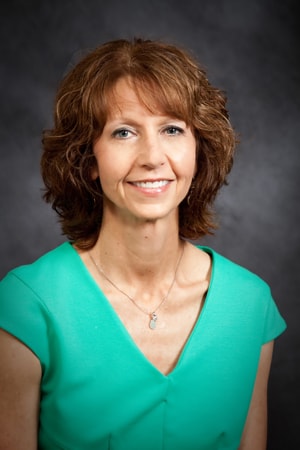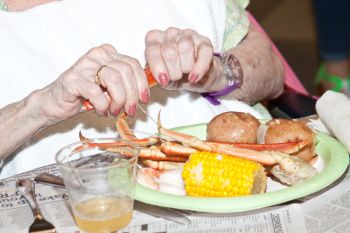Knitting groups
 For a small group of Homeland Center residents, their twice-weekly knitting circle isn’t just a chance to chat as they create intricate patterns. These four ladies knit with a purpose – creating slippers for homeless women and children.
For a small group of Homeland Center residents, their twice-weekly knitting circle isn’t just a chance to chat as they create intricate patterns. These four ladies knit with a purpose – creating slippers for homeless women and children.
The effort started in the early 2000s, when a former resident taught some friends the simple pattern for slippers, knitted in one piece, folded, and sewn together at the seams.
“We make them from very small to real big,” says Lou Hepschmidt, the knitting group’s unofficial leader.
The resulting slippers are taken to the Women and Children’s Shelter at nearby Bethesda Mission. Since 1914, Bethesda Mission has provided food and shelter for Harrisburg area’s homeless and hungry. Like Homeland Center, the shelter was founded to provide compassionate care for those who had nowhere else to turn.
The Homeland knitting group is an egalitarian bunch, open to anyone who wants to sit and knit a while. An endless supply of yarn comes from the members’ own stashes of skeins accumulated over the years.
“We have patterns galore, and knitting materials,” says Hepschmidt. “Needles and supplies, we have plenty of. Nobody has to buy anything to join our group.”
Knitter Mary Andrews recalled that history is full of women knitting for others in need, including her time knitting socks for soldiers in World War II. She’s glad to continue the tradition.
“Many of these people come into this shelter with nothing except the clothing on their back,” she says.
“It’s a good feeling every time I finish one of these,” Hepschmidt agrees. She recalls delivering booties that were hardly in the building for a minute before a mother had them on her baby’s feet. “Most of them have nothing,” she says.
Betty Ludwig also knits stocking caps – more than 100 in recent years – that her church distributes to the poor or sells for fundraisers. While she knits, she thinks about her small part in easing the burden on struggling mothers.
“I’m very pleased that I can make some hats to help keep their children warm in the winter,” Ludwig says. “It’s a good feeling to know that you’re using your spare yarn to help these children.”
Shirley Fisher recalls the time they took hats to the shelter and were rewarded with applause. “It was cold weather,” she says, “and none of them had any hats.” As she knits, she thinks about the children who will use the slippers or hat, and she prays “that parents are good to their children.”
Ludwig likes to think about the distances that their hand-knit items travel and the places they take their recipients.
“Our knitting goes pretty far,” she says. “Just think how excited a child would be when they’re handed a hat or scarf. It gives you a good feeling.”

 It’s perhaps the most insidious of all diseases. Dementia doesn’t sicken the body. It steals the mind, slowly robbing an individual’s very essence, their personality. All that makes them who they are.
It’s perhaps the most insidious of all diseases. Dementia doesn’t sicken the body. It steals the mind, slowly robbing an individual’s very essence, their personality. All that makes them who they are. Debbie Haas, director of skilled-care admissions and the 21- bed Ellenberger Unit for those with dementia, advises family members to be aware of subtle changes in a loved one’s usual routines. Are bills going unpaid? Is their hygiene slipping? Are they wearing the same clothes? Not eating well? Forgetting to take their medicine?
Debbie Haas, director of skilled-care admissions and the 21- bed Ellenberger Unit for those with dementia, advises family members to be aware of subtle changes in a loved one’s usual routines. Are bills going unpaid? Is their hygiene slipping? Are they wearing the same clothes? Not eating well? Forgetting to take their medicine? She recommends resources like the Alzheimer’s Association and the dementia care book, entitled “The 36-hour Day.”
She recommends resources like the Alzheimer’s Association and the dementia care book, entitled “The 36-hour Day.” “Read the patient,” advises Haas. “As the day progresses, they get more confused. We call this sun-downing. As the day goes on, as they are more tired, it does change them. Gauge when your loved one is more awake and lucid. Don’t bring it up when they are frustrated, or you are frustrated. Bring up the conversation when everyone is clam.”
“Read the patient,” advises Haas. “As the day progresses, they get more confused. We call this sun-downing. As the day goes on, as they are more tired, it does change them. Gauge when your loved one is more awake and lucid. Don’t bring it up when they are frustrated, or you are frustrated. Bring up the conversation when everyone is clam.” Maybe you get scared after seeing an older loved one fall. Or your mom or dad is getting more than a little confused — not forgetting the keys but forgetting what they are for. Perhaps a former happy homemaker begins letting things go; the house is dirty, personal hygiene slips.
Maybe you get scared after seeing an older loved one fall. Or your mom or dad is getting more than a little confused — not forgetting the keys but forgetting what they are for. Perhaps a former happy homemaker begins letting things go; the house is dirty, personal hygiene slips. The first thing families considering any kind of residential care for their aging loved one need to know is that nobody has failed.
The first thing families considering any kind of residential care for their aging loved one need to know is that nobody has failed. Once a family has seen the signs of decline in an aging loved one and decided they can no longer live on their own, the next step is to convince the loved one that a change is needed. In this, it’s better not to go it alone.
Once a family has seen the signs of decline in an aging loved one and decided they can no longer live on their own, the next step is to convince the loved one that a change is needed. In this, it’s better not to go it alone. You’re almost there. With the help of your loved one’s doctor, you’ve convinced them that transiting to a personal care or nursing facility is the right move for their health, safety and welfare – not to mention maximizing their social life.
You’re almost there. With the help of your loved one’s doctor, you’ve convinced them that transiting to a personal care or nursing facility is the right move for their health, safety and welfare – not to mention maximizing their social life.
